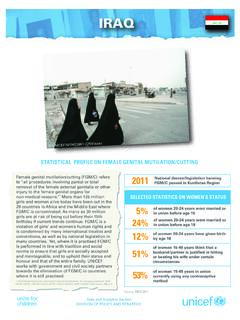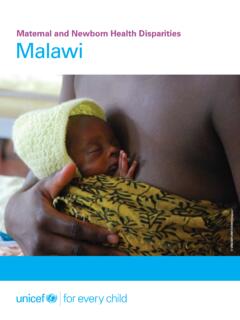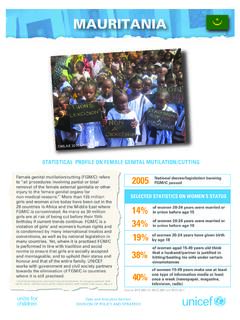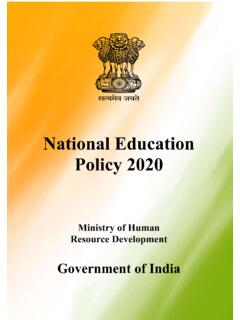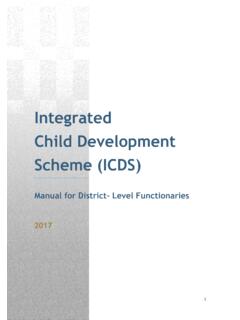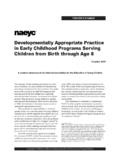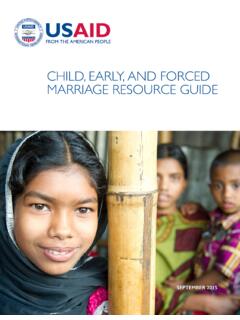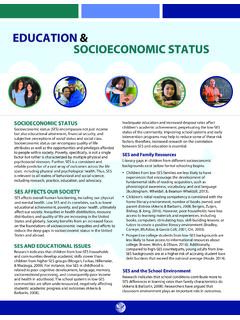Transcription of Boys and Girls Sex-disaggregated data on a selection of in ...
1 Boys and Girls Sex-disaggregated data on a selection of in the Life Cycle well-being indicators, from early childhood to young adulthood DIVISION OF POLICY AND PRACTICE. Acknowledgements This publication was prepared by the Statistics and Monitoring Section, Division of Policy and Practice, UNICEF. Claudia Cappa and Colleen Murray developed, contributed to and coordinated the project under the direction of Tessa Wardlaw. Inputs were also provided by Priscilla Akwara, David Brown, Danielle Burke, Xiaodong Cai, Liliana Carvajal, Archana Dwivedi, Anne Genereux, Rouslan Karimov, Nyein Nyein Lwin, Holly Newby and Danzhen You.
2 Valuable feedback was offered by Geeta Rao Gupta, Rina Gill, Richard Morgan and Daniel Seymour. Big Yellow Taxi, Inc. was responsible for art direction and design. The publication was edited by Pamela Knight. United Nations Children's Fund (UNICEF), Division of Policy and Practice, 2011. Cover photo UNICEF/NYHQ2007-2541/Bell Permission is required to reproduce any part of this publication. Please contact: United Nations Children's Fund Division of Policy and Practice 3 UN Plaza New York, NY 10017, USA. Email: Tel: +1 212 326 7000. Permission to reproduce any part of this publication will be freely granted to educational or non-profit organizations.
3 Others will be requested to pay a small fee. UNICEF has taken all reasonable precautions to verify the information contained in this publication. For any data updates subsequent to printing, please visit < >. Overview This report presents the most comprehensive compilation to date of Sex-disaggregated statistics on children and young people in the developing world. It examines a selection of indicators that are currently available to measure well-being and assess children's rights. During the past decade, an unprecedented amount of internationally comparable household survey data has become available for a broad range of indicators covering many countries.
4 This wealth of new information has been analyzed to provide global, regional and country estimates on a wide variety of issues. By presenting Sex-disaggregated data across the main stages of childhood and adolescence, an evidence-based assessment of gender differentials is offered, which may help to inform future policies and programmes. The data indicate that important gender imbalances exist in the population structure in some countries, particularly in parts of Asia, resulting in a higher deficit of Girls than normal. Among the surviving children, available data suggest, perhaps surprisingly, that in early childhood , gender disparities are relatively small among the indicators examined.
5 Overall, children are equally likely to be registered at birth irrespective of sex. Exclusive breastfeeding rates in the first six months of life are similar for both sexes in most countries with available data. The likelihood of being undernourished is the same for boys and Girls under five. Boys and Girls are also equally likely to benefit from malaria interventions, and to receive proper care for diarrhoeal diseases and pneumonia the two leading causes of under-five deaths. In most countries with available data, similar proportions of boys and Girls attend preschool education (although overall attendance rates are still low in many countries for both sexes) and are subject to violent discipline at home.
6 However, gender disparities become more evident as children approach adolescence. Gender parity in primary education is now common throughout the world, but is less likely at the secondary level. Available data show that Girls are significantly more likely than boys to be married as children and to begin having sex at a young age, often as a result of imbalanced power dynamics between the two sexes. An earlier introduction to marriage and sex can set young women down a path of greater risk for several adverse outcomes, including risks associated with early childbearing and exposure to sexually transmitted infections.
7 Adolescent Girls have higher rates of anaemia. They are also more likely to report that a husband is justified in beating his wife under certain circumstances, reflecting societal norms that can make Girls in union more vulnerable to domestic violence. Young women are less likely to be literate than young men and are less likely to BOYS AND Girls IN THE LIFE CYCLE 1. make use of information media. Young men are better informed about HIV/AIDS. and are also more likely to protect themselves with condoms. Ultimately, young women in sub-Saharan Africa are two to four times more likely to be infected with HIV/AIDS than young men.
8 It is important to note that this publication is not intended to provide a definitive overview of gender disparities in childhood . Human well-being encompasses multiple dimensions, including not only physical but also cognitive, social and emotional aspects. All these facets are inextricably linked to socialization processes throughout the life cycle and are permeated by culturally defined gender roles and expectations. However, many of these important aspects are difficult to measure, and Sex-disaggregated data may not always be available. This publication including its more surprising findings should therefore be interpreted in the context of more in-depth gender studies and qualitative research, and should encourage further analyses of the available data.
9 Finally, even if some of the indicators presented in the following pages show little or no difference by sex, this does not mean that differential or discriminatory treatment may not be occurring. Technical notes on the data Gender parity index Statistical tables The gender parity index (GPI) is a ratio of two prevalence Most figures in the body of this report present regional and estimates that is designed to measure the relative position global estimates. For data by country, please see the statistical of females over males with regard to certain well-being tables at the end of the publication. indicators. A ratio of ( ) indicates that males and females are equally likely to achieve a given outcome.
10 Regional estimates Ratios greater than indicate that females are more likely Regional estimates are presented only when the available data than males to achieve such an outcome, while values less are representative of at least 50 per cent of the population of than indicate the opposite. In the case of stunting, the corresponding regions, unless otherwise noted. Regrettably, the window of gender parity is wider ( ) since the many estimates do not include China, as comparable data are prevalence estimates are relatively low and bear a level often not available in UNICEF databases for this country. For of uncertainty when calculated from survey data.
